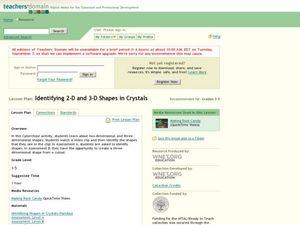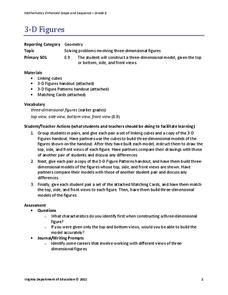Curated OER
Volume Lesson
Name that shape! Your math class identifies cubes and other three-dimensional products. They practice calculating the volume of cubes and identify cubes around them in the classroom. Worksheets and directions are provided.
Curated OER
Greek Mythology Character Cubes
Students research Greek myths and identify characters from ancient Greece. After discussing the names, descriptions, scenes an objects in Greek mythology, they draw pictures on tiles and write descriptions. Students join the tiles...
Curated OER
Name the 3 Dimensional Shapes of the Objects
Here are six solid figures for learners to identify. The names are listed along the left side and the shapes pictured on the right. Each shape is shown as a familiar object instead of just a drawing. Figures include a cylinder,...
Curated OER
Recognize and Draw Shapes
What type of shape is this? Learners practice identifying shape attributes as they name a parallelogram and an oval and count the sides of a cube and a triangle. There are multiple-choice answers for the shape-name questions, so...
Curated OER
Identifying 2-D and 3-D Shapes in Crystals
Learners view a video on making rock candy and identify the shapes they see while watching. In this 2 and 3 dimensional shape instructional activity, students recognize shapes and complete worksheets to identify them. Learners build a...
Curated OER
Number Rods
Working in a math center or an "I finished early" work station, young mathematicians will match in sequence pre-set-up rods of unifix cubes to numbers on a number line. To help differentiate tens from ones, use different colors to...
Curated OER
Solving Polynomial Equations
This worksheet and tutorial explores solving more complex polynomials by graphing each side separately and finding the point of intersection, identifying the sum and differences of cubes, and solving higher degree polynomials by using...
World Wildlife Fund
Shapes
Investigate the properties of three-dimensional figures with this Arctic-themed math lesson. Beginning with a class discussion about different types of solid figures present in the classroom, young mathematicians are then given a...
American Chemical Society
What is Density?
Density: the reason a giant pumpkin will float, but a tiny cranberry won't. Lesson begins with a demonstration of two of the same-sized cubes having different densities. Then pupils take eight cubes, each of the same size, and have to...
Curated OER
Why Do Ice Cubes Melt?
First graders investigate water properties by participating in a hands on experiment. In this ice formation lesson, 1st graders examine real ice cubes in a bowl and identify the reasons why certain cubes melt faster than others. Students...
Curated OER
Identify the shape of balloons
In this shapes worksheet, students identify the shape of balloons. Students choose from a cube, a circle, and a sphere to identify the balloon's shape.
Curated OER
Identify Shapes and Matching Parts
Students identify real world objects as shapes they have learned. In this 3-D shapes worksheet, students identify shapes such as a cube for a box, a sphere for a globe, and a cylinder for a soup can.
Curated OER
Identify the shape of the star
In this star instructional activity, students identify the shape shown to them and choose what shape it is. Students complete 1 multiple choice question.
Curated OER
The Five Number Game
Students explain what it means to square numbers. They explain what it means to cube numbers. Students define prime numbers using their own language. They are introduced to the problem by playing one game as a class.
Curated OER
Making Patterns - Create, Analyze, and Predict
Fourth graders practice making patterns using Unifix cubes and identify, analyze, and determine rules for describing numerical patterns involving operations and nonnumerical growing patterns. They also find an example of a pattern in...
World Wildlife Fund
Arctic Shapes
In a two-part worksheet, young geometers examine 3-D shapes and describe their attributes in a table. They will be able to draw the shape and name the number of vertices, faces, and edges. In the second part, individuals explore nets of...
Virginia Department of Education
3-D Figures
Scholars construct three-dimensional figures to study dimension and side views. Learners build models using linking cubes to match views of different sides. After practicing with models, they attempt to match three-dimensional drawings...
Learner
Solid Shapes
A collection of two lessons, kindergartners will identify two-dimensional shapes in solid shapes. They will develop basic knowledge of the components that make up a sphere, rectangular prism, pyramid, cylinder, cone, and cube. Young...
EngageNY
Mastering Factoring
Math class is full of drama—there are so many problems to work out! Pupils work out factoring problems. They use quadratic methods of factoring higher degree polynomials, in addition to factoring the sum and difference of two cubes.
Curated OER
Probability
In this mathematics worksheet, 6th graders identify what probability is and what it measures. They write the number of favorable and possible outcomes for each and display as a ratio.
Curated OER
Geometric Shapes: Which Item?
Which item is shaped like a cone? Give students a chance to compare shapes, determining which item represents the prompted shape or figure (and which don't). Through 4 multiple-choice questions, scholars identify a cone, a cube, a...
Curated OER
Faces of a Cube
Learners identify and correctly name three-dimensional solids; cones, spheres, and cubes. In this three-dimensional figures lesson, students build a cube by matching colored square faces to a correct word. Learners then explore...
Curated OER
Origami Cubes
Fourth graders use an origami design to make a set of cubes. Individually, they identify the characteristics of different quadrilaterals as they are folding the paper into cubes. To end the lesson plan, they make a new design with new...
Civil War Trust
Contrasting the North and South before the War
Learners create a standing cube with four panels that display information on the North and South's economy, geography and climate, society, and means of transportation before the Civil War. Through discussion and reading informational...

























